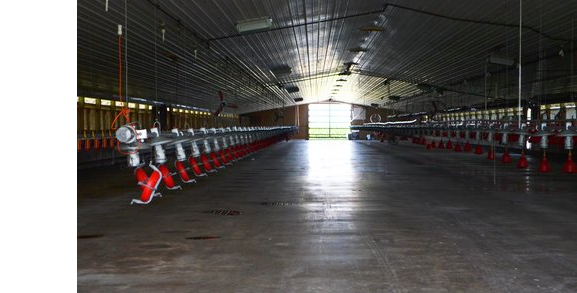Managing internal risks
Within the farm, it is important to minimize the spread of pathogens. This includes set up of a proper barn entry system with separate personnel clothing. Once inside the barns, cleaning and disinfection will stop the spread of pathogens between flocks.
Farm entry procedures
Danish Entry System is a common barn entry style that is fairly easy to set-up and very effective at preventing pathogen entry. The images on the right are two examples: a two-zone and a three-zone layout with shower. The three-zone layout is typically used for a farm entrance, and the two-zone layout can be used for individual barn entrance. As long as separate interior and exterior zones are maintained, this will reduce pathogen transfer.


Anyone entering the turkey barns should sanitize their boots in the dip pan provided at each entry door.
- All dip pans should contain a clean residual disinfectant solution that is changed daily.

Do not enter the barn without taking precautions. Personnel clothing will help to prevent disease transmission from movement of people on the farm. Staff should
- Change into different barn boots or wear disposable boot covers
- Change into clean coveralls
- Sanitize hands
- Be sure to launder farm clothing regularly
Barn Cleaning and Disinfection
To best control and manage pathogens from entering your barns, we recommend an all-in all-out protocol. This means that flocks should be of one type of poultry and of one age group. This way, the farm site can be cleaned and disinfected properly to break the pathogen cycle when all birds are gone. An all-in all-out protocol means the least amount of risk for disease transmission.
Downtime
Adequate downtime between flocks to minimize or eliminate potential pathogens is essential. 21 days of downtime is recommended, with 7 of the 21 days as empty rest. This rest time should occur after cleaning and before you begin set up for the new flock.

Cleaning and disinfection should be done between each flock to help prevent flock health issues. Follow the same steps for cleaning whether it is a brooder or finisher barn.
Dry debris cleaning
- Remove excess feed from the feed bins, feed pans, and fill system.
- Make sure all litter is removed from the brooder barn - this includes sweeping the floor.
Wet surface cleaning
- Wash the entire barn and entry area with a pre-wash solution.
- Include vents, fans, fan housings, fan shutters, stoves, drinkers, feed pans, and feed lines.
- Be certain that all dirt and debris (organic matter) has been removed.
- Allow building to dry for 24 hours. This may be the single most important step for sanitation.
Disinfection
- Spray entire building with a disinfectant (strong broad spectrum virucidal veterinary disinfectant).
- Include vents, fans, fan housings, fan louvers, stoves, drinkers, curtains, bird wire, feed pans, and feed lines.
- Spray floor and walls with a strong residual disinfectant.
- Allow building to dry for 24 hours.
- After new bedding is spread, apply insecticide for darkling beetles on top of the litter. Follow a sound rotational insecticide program in accordance with label instructions and local laws.
- After bedding is spread, thermal fog the entire barn for additional disinfection.
Water sanitation programs
Clean water reduces stress on the animals and helps to prevent common health issues such as Bordetella, E.coli, and salmonella. Water sanitation is a crucial aspect of preventing pathogens.
